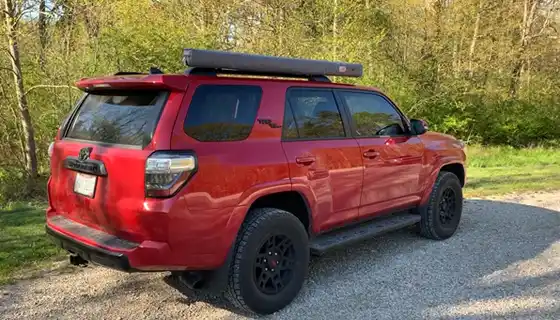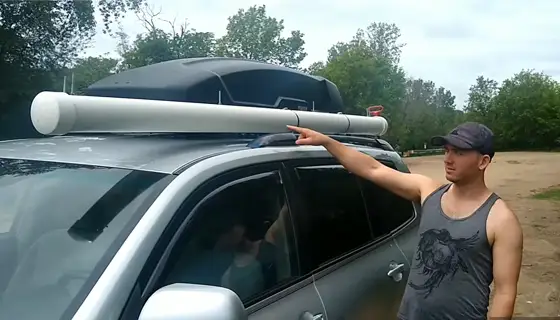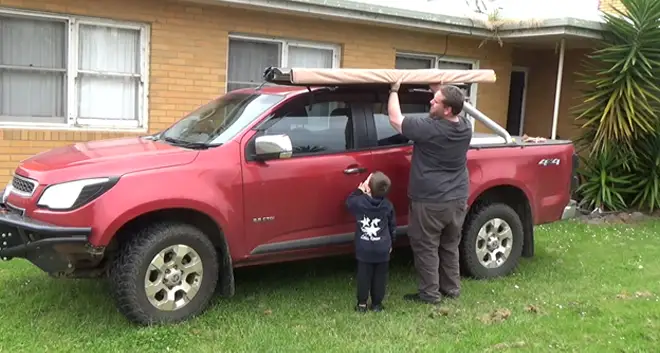Last Updated on April 11, 2023
Mounting RV awnings may require extra work, and it can be even more complex to set up without a roof rack. When installed incorrectly on the roof or the RV side without a roof rack, the mount may slide off in high winds & pose a life-threatening risk.
So you may wonder how to mount an awning without a roof rack on an RV with an awning bracket kit & mounting hardware. Some RVs may not accept traditional roof-mounted units or roof racks, and mounting an awning without these may seem complicated. But modern technology has made this process much easier today.
With some necessary equipment, anyone can mount an awning on their vehicle without installing additional roof racks or rooftop equipment by performing some easy steps. The following article will provide a step-by-step guide to mounting an awning without roof racks on an RV and other similar vehicles.
How to Mount Awning Without Roof Rack Using Mounting Hardware & Bracket Kit?

Mounting an awning sans a roof rack is a straightforward and cost-effective way to provide shade and shelter for outdoor activities. With proper preparation and the right tools, you can easily mount an awning without spending money on costly roof racks or drilling holes into your vehicle.
The following steps will assist you in installing a roof rack awning without any roof rack:
Step 01: Gathering Tools & Materials
To mount an awning, you’ll need the following supplies:
- Tape measure
- Awning
- Mounting hardware (screws, bolts, etc.)
- Power drill
- Drill bit (the size will depend on the mounting hardware you are using)
- Small piece of tape (if needed)
Once you have these necessary supplies, you can begin mounting the awning. Be sure to read all instructions that come with your awning and hardware before beginning the installation process.
Step 02: Measure the Awning Frame and Determine the Mounting Area
Awning frames are measured and determined by the mounting area. To measure the width of an awning, you need to measure it at its longest point (typically the distance between two mounting brackets). This measurement should be taken very carefully and accurately as it will determine how much space is needed for installation on Rv.
You need to measure the height of the awning at its highest point (usually from ground level up to the highest point where it will be mounted). You should also measure additional components, such as support poles and tie-down straps.
These measurements should be recorded to ensure that your awning frame fits perfectly within its designated area. Once all measures have been gathered and recorded, you must consider where exactly on your property or structure you would like to install your awning frame.
Now, you will need to select & mark an area that provides enough space for installation and sufficient clearance around the installed item. It is usually best practice to leave at least three feet of clear space around each side of an installed awning frame, as this helps prevent damage from weather exposure.
Step 03. Clean and Prep the Areas for Mounting Hardware
Before setting up the awning mounting hardware, you should clean and prep the area where the hardware will be mounted. This will ensure that the hardware is correctly installed and that the awning functions properly.
Start by cleaning the selected mounting surface. If the surface was painted or stained, use a mild detergent to remove any dirt or oil from the surface before sanding down any high spots or rough edges. Once cleaned, allow the surface to dry completely before proceeding with the installation.
Step 04: Drill Pilot Holes According to the Hardware Manufacturer’s Instructions
Drilling pilot holes is necessary when installing awning mount hardware, such as screws and bolts, into solid materials. You must ensure that the pilot hole is drilled according to the mounting hardware manufacturer’s guidelines to avoid damaging the material or creating an improperly secured fastener.
When drilling pilot holes, ensure that you use the correct drill bit size recommended by the hardware manufacturer. If you use too large of a drill bit, there is potential for it to slip off course while drilling and cause damage to the surrounding area.
If you use too small of a drill bit, your fastener may become loose over time due to an improperly sized hole. Also, if you do not correctly center your bit when drilling, your fastener may not be completely secure once inserted. Ensure the area is flat and strong enough to support the awning’s weight before drilling.
When drilling pilot holes, you need the correct drill technique and angle. Ensure your drill bit enters at an angle that allows it to cut through with minimal resistance and without slipping off course. You can also use a clamp or vice on your workpiece to reduce vibrations and give you more control once you start drilling.
Step 05: Attach the Mounting Hardware & Bracket Kit
Once your holes are drilled, seal each hole before placing any mounting hardware screws. This will help protect against water entering your vehicle or home from around these holes.
After this, slide the awning mounting bracket within each hole and secure it with screws. Make sure each screw is tight for added security so that there won’t be any slipping when under load from an attached awning.
Step 06. Assembling the Awning Frames and Connect Them to the Brackets
Now that you have firmly mounted the universal bracket, you can assemble the awning mounting hardware and bracket kit using provided bolts and nuts with the hardware set, which come in several sizes depending on the type of frame you choose for your awning setup.
These bolts should fit snugly into each corner of the frame, and then you can use nuts to secure them in place, so they don’t come loose over time during your awning setup.
Consider using a thread locker on these bolts and nuts as an extra precaution against them coming loose over time due to vibration or wear and tear during your awning setup.
Step 07: Test the Installed Awning Before Use for Security
After assembling your awning frames and connecting them to the mounting hardware, it’s essential to test that everything is secure before use.
Ensure all brackets, screws, and bolts are securely attached to the roof rack and the awning. Once you have confirmed their securement, you can begin testing the strength of your installation.
Start by gently tugging on each part of the awning, looking for any signs of movement or wobbling while also checking for wear or damage in any areas that may be difficult to see with just visual inspection. Before using your awning, you’ll need to repair anything that appears loose or out of place.
Other Ways to Mount an Awning Without Roof Racks

There are a few methods for mounting an RV awning, but the method described above is the most common. The following are a few other options you should consider:
Method 01: Install Awning Tracks on the RV Roof
Installing heavy duty awning tracks on an RV or similar vehicle roof provides an easy way to mount awnings. The tracks are mounted directly onto the roof, allowing you to attach your awning easily. In fact, with just some basic tools and a few materials, you can have your new awning tracks up on the roof in no time.
Many RVs have aluminum roofs, which must be outfitted with an appropriately-sized support plate to secure the tracks securely. Once you’ve confirmed that your vehicle is adequately prepared for installation, it’s time to begin the job.
Start by measuring the area where you plan to place the track so that it fits correctly without any issues. After this, lay out its location using a measuring tape and mark it with a pencil or pen if necessary.
Now grab your drill and make pilot holes (you may need to drill holes in multiple locations) using a drill bit slightly smaller than the screws used to affix them. Once all these holes have been drilled out, place individual tracks along your marked area and align them as best as possible before securing them with screws.
If necessary (depending on access), use an extension cord connected to an electric drill to reach those hard-to-reach areas while drilling into your RV’s roof. Also, you may need to apply silicone sealant around each screw when installed to create a watertight seal and prevent leaks from occurring over time due to exposure to rain or other moisture sources.
Method 02: Use Suction Cups to Mount the Awning
Using suction cups to mount an awning on your RV or other Vehicle is a great way to provide additional shade and protection. This process requires using vacuum suction cup anchors with securing hooks, which are easily affordable and can be found at most hardware stores.
These suction cups can securely hold the awning when properly installed, which is why they are often the preferred choice by many RV owners who don’t have a roof rack. The hook portion of each cup should be inserted into its respective cup before being secured by tightening the small screws provided with each package of anchor hooks.
After all the anchor hooks are successfully mounted onto their respective cups, they should be placed on the desired mounting surface. For best results, press down on each cup firmly and evenly so that there are no air gaps between them and the mounting surface.
Are There Any Risks to Mounting an Awning with No Roof Rack?

Several potential risks should be considered when installing an RV awning without a roof rack. Primarily, the force exerted by wind can cause damage to the vehicle body if it is not adequately secured. You’ll likely get scratches, dents, and other damage with a vehicle awning without a roof rack.
Another possible risk of attaching an RV awning without roof racks is water damage. Water can pool in places where it’s not supposed to and cause rust or other serious issues. Rain may also create pools of standing water on top of the vehicle itself, which can seep into the interior through the holes and cause internal damage if not sealed properly.
Also, mounting points can be subjected to increased stress, eventually cracking or breaking under too much load without a roof rack installed with additional support from footpads or cross-roof bars for the awning frame. This could leave you stranded roadside with major repair bills on your hands.
Are All RV Compatible With an Awning Without Using a Roof Rack?
No, not all RVs can be equipped with an awning when not using a roof rack. The size and type of RV you have will determine whether or not you can install an awning without needing additional support from a roof rack system.
Generally speaking, smaller RVs such as pop-ups and Class B and C motorhomes are great candidates for installing an awning without needing extra support from a roof rack. But, larger RVs such as Class A motorhomes and fifth-wheel trailers may require additional support to use an awning safely.
Is it Worth Mounting an Awning Without Having a Roof Rack?
When mounting an RV or vehicle awning without the use of a roof rack, some pros and cons should be taken into account.
Doing so will save money because you will not have to buy or install a roof rack. This can be especially beneficial for those who are on a tight budget. Also, some may find the installation process of installing an awning much more straightforward than having to install a roof rack.
Conversely, not having a roof rack can lead to certain limitations regarding what type of awning you can use. Without roof racks, many of these awning models may be unable to withstand strong winds or other external pressures.
In conclusion, if you don’t need the strongest awning and are looking for an inexpensive option, mounting one without a roof rack might be wise. In areas that experience strong winds or if you are considering buying a larger RV, you should invest in a quality roof rack before making your purchase.



